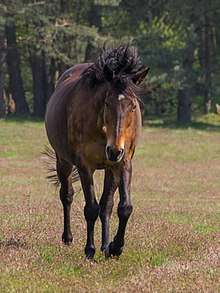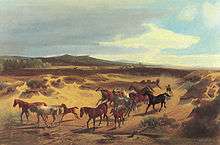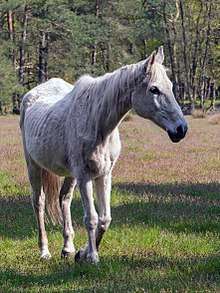Senner
The Senner or Senne is a critically-endangered German breed of riding horse. It is believed to be the oldest saddle-horse breed in Germany, and is documented at least as far back as 1160.[5][6] It is named for the Senne, a natural region of dunes and moorland in Nordrhein-Westfalen, in western Germany, and lived in feral herds there and in the Teutoburger Forest to the east.
 In the Moosheide nature reserve, 2016 | |
| Conservation status | |
|---|---|
| Other names |
|
| Country of origin | Germany |
| Use | |
| Traits | |
| Weight |
|
| Height | |
| Colour | any |


It is a warmblood, and has been influenced at various times by Arab, Anglo-Arab, Thoroughbred and Iberian stock.[4]:502 It may have contributed to development of the Hanoverian.[7]:186
History
The origins of the Senner are not known; many records of the history of the breed were destroyed by fire in 1945. Herds of feral horses in the Senne moorlands are documented in several Mediaeval sources, one of which dates from 1160.[6] The Senne lay within the Principality of Lippe, and the horses were raised to provide mounts for the ruling Lippe family.[6] The centre of breeding was at Detmold until 1680, when it was moved to the stables of the Jagdschloss Lopshorn near Augustdorf.[5] The horses were kept all year round on the heathland of the Senne and in the neighbouring Teutoburger Forest. Numbers were never very high; the number of breeding mares averaged about forty.[6] Breeding records were kept from the early years of the eighteenth century, and a stud-book started in 1713.[8] There were four dam lines in the breed; only one of these, dating to 1725, survives.[5]
From the late seventeenth century, some Arab blood was introduced; English Anglo-Arab and Thoroughbred blood was introduced towards the end of the eighteenth century. In the early twentieth century, after the First World War, there was some addition of Andalusian blood.[4]:502
The Lopshorn castle was destroyed by fire in 1945. In 1946 the remaining Senner stock was dispersed to various owners.[6] In 1999, some were introduced to the Moosheide nature reserve to assist in conservation grazing.[4]:502
In 2007 the FAO listed the conservation status of the Senner as "critical".[1]:112 In the Rote Liste of the Gesellschaft zur Erhaltung alter und gefährdeter Haustierrassen, it is listed in Category I, "extremely endangered".[2][5] In 2015 the total breeding population was reported at twenty-five head – nineteen mares and six stallions.[3]
Characteristics
The principal coat colours are bay and grey; black and chestnut also occur.[4]:502[9] Some horses show primitive markings including a dorsal stripe and zebra-striping on the legs.[6]
Use
The Senner was bred principally as a riding horse, even in times when working horses were in demand; it was also used as a carriage horse. Senner stallions stood at the royal stud of Weil bei Esslingen in Baden-Württemberg and at the state stud of Lipizza in the Austrian Empire.[6]
In modern times it may be used for competition or recreational riding.[6]
References
- Barbara Rischkowsky, D. Pilling (eds.) (2007). List of breeds documented in the Global Databank for Animal Genetic Resources, annex to The State of the World's Animal Genetic Resources for Food and Agriculture. Rome: Food and Agriculture Organization of the United Nations. ISBN 9789251057629. Accessed July 2017.
- Die Rote Liste im Überblick (in German). Gesellschaft zur Erhaltung alter und gefährdeter Haustierrassen. Accessed July 2017.
- Senner/Germany. Domestic Animal Diversity Information System of the Food and Agriculture Organization of the United Nations. Accessed July 2017.
- Valerie Porter, Lawrence Alderson, Stephen J.G. Hall, D. Phillip Sponenberg (2016). Mason's World Encyclopedia of Livestock Breeds and Breeding (sixth edition). Wallingford: CABI. ISBN 9781780647944.
- Senner (in German). Gesellschaft zur Erhaltung alter und gefährdeter Haustierrassen. Accessed July 2017.
- Mathias Vogt (1995). Schwerpunkt - Pferde: Der Senner - die älteste Reitpferdezucht in Deutschland (in German). Gesellschaft zur Erhaltung alter und gefährdeter Haustierrassen. Accessed July 2017.
- Elwyn Hartley Edwards (1994). The Encyclopedia of the Horse. London; New York; Stuttgart; Moscow: Dorling Kindersley. ISBN 0751301159.
- Karl-Ludwig Lackner ([s.d.]). Die Geschichte der Sennerzucht (in German). Zuchtverband für Senner Pferde. Accessed July 2017.
- Zuchtprogramm für die Rasse des Senner Pferdes (in German). Zuchtverband für Senner Pferde. Accessed July 2017.